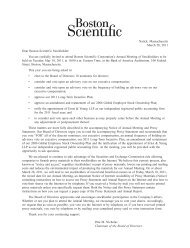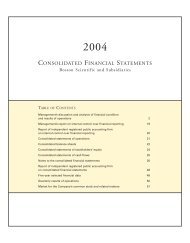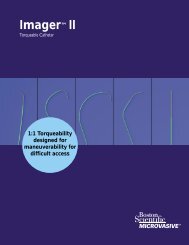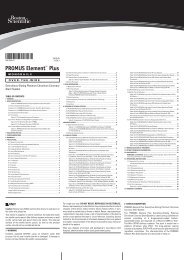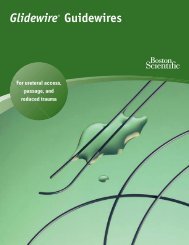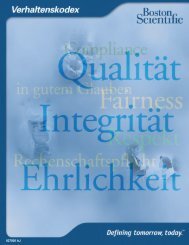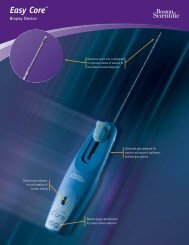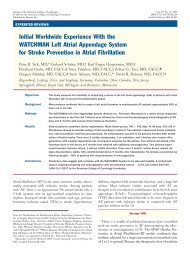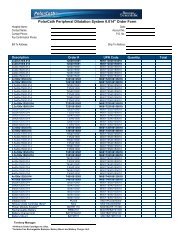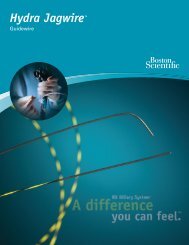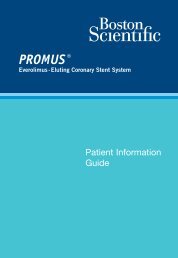Physician Reimbursement Primer for Cardiac ... - Boston Scientific
Physician Reimbursement Primer for Cardiac ... - Boston Scientific
Physician Reimbursement Primer for Cardiac ... - Boston Scientific
Create successful ePaper yourself
Turn your PDF publications into a flip-book with our unique Google optimized e-Paper software.
Chapter 3<br />
3. Sino-atrial block or sinus arrest without significant symptoms.<br />
4. Prolonged P-R intervals with atrial fibrillation (without third-degree AV block) or with<br />
other causes of transient ventricular pause.<br />
5. Bradycardia during sleep.<br />
6. Right bundle branch block with left axis deviation (and other <strong>for</strong>ms of fascicular or<br />
bundle branch block) without syncope or other symptoms of intermittent AV block.<br />
7. Asymptomatic second-degree AV block of Type I unless the QRS complexes are<br />
prolonged or electrophysiological studies have demonstrated that the block is at or<br />
beyond the level of the His bundle (a component of the electrical conduction system<br />
of the heart).<br />
Effective October 1, 2001<br />
8. Asymptomatic bradycardia in post-myocardial infarction patients about to initiate<br />
long-term beta-blocker drug therapy.<br />
Group II. Dual-chamber <strong>Cardiac</strong> Pacemakers<br />
Effective May 9, 1985<br />
A. Nationally Covered Indications<br />
Conditions under dual-chamber cardiac pacing are considered acceptable or necessary<br />
in the general medical community unless conditions 1 and 2 under Group II. B. are<br />
present:<br />
1. Patients in whom single-chamber pacing (ventricular pacing) at the time of<br />
pacemaker insertion elicits a definite drop in blood pressure, retrograde conduction,<br />
or discom<strong>for</strong>t.<br />
2. Patients in whom the pacemaker syndrome (atrial ventricular asynchrony), with<br />
significant symptoms, has already been experienced with a pacemaker that is being<br />
replaced.<br />
3. Patients in whom even a relatively small increase in cardiac efficiency will importantly<br />
improve the quality of life, e.g., patients with congestive heart failure despite<br />
adequate other medical measures.<br />
4. Patients in whom the pacemaker syndrome can be anticipated, e.g., in young and<br />
active people.<br />
Dual-chamber pacemakers may also be covered <strong>for</strong> the conditions as listed in<br />
Group I. A., if the medical necessity is sufficiently justified through adequate claims<br />
development. Expert physicians differ in their judgments about what constitutes<br />
appropriate criteria <strong>for</strong> dual-chamber pacemaker use. The judgment that such a<br />
pacemaker is warranted in the patient meeting accepted criteria must be based upon the<br />
individual needs and characteristics of that patient, weighing the magnitude and<br />
likelihood of anticipated benefits against the magnitude and likelihood of disadvantages<br />
to the patient.<br />
B. Nationally Noncovered Indications<br />
Whenever the following conditions (which represent overriding contraindications) are<br />
present, dual-chamber pacemakers are not covered:<br />
1. Ineffective atrial contractions (e.g., chronic atrial fibrillation or flutter, or giant left<br />
atrium).<br />
2. Frequent or persistent supraventricular tachycardias, except where the pacemaker is<br />
specifically <strong>for</strong> the control of the tachycardia.<br />
14 <strong>Physician</strong> <strong>Reimbursement</strong> <strong>Primer</strong> <strong>for</strong> <strong>Cardiac</strong> Rhythm Management



